octobre 19, 2023
918
Texas Instruments (TI) has introduced a new signal isolation semiconductor product combination called the Opto-Isolators (ISOM8710 and ISOM8110). These devices are designed to enhance signal integrity, reduce power consumption, and extend the lifespan of high-voltage industrial and automotive applications.
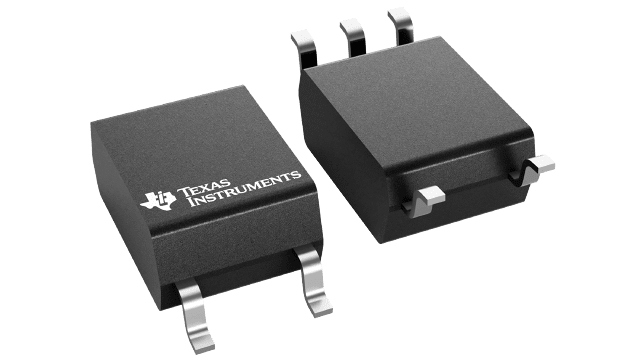
ISOM8710 and ISOM8110
If you have any needs for products, please contact our sales staff for inquiry. https://www.censtry.com/inquiry.html
TI's Opto-Isolators are compatible with the commonly used optocouplers in the industry, making them easy to integrate into existing designs while benefiting from TI's proprietary silicon dioxide (SiO2)-based isolation technology. This technology aims to address the challenges associated with aging effects in optocouplers, particularly those related to LEDs.
Azhar Mohammed, TI's Isolation Product Line Manager, stated in an interview that the Opto-Isolators represent a significant advancement in high-voltage signal isolation compared to traditional optocouplers.
Dielectric Material: The Opto-Isolators use SiO2 as the dielectric material, providing excellent insulation performance compared to the air gaps commonly found in optocouplers.
Temperature Range: These devices can operate over a wide temperature range from -55°C to 125°C while maintaining stable performance.
Data Rate: The Opto-Isolators offer improved data rate performance, making them a better choice for high-speed applications. The data rate for digital signals goes up to 25 Mbps (ISOM8710), and the high bandwidth for analog signals is 680 kHz (ISOM8110).
Common-Mode Transient Immunity (CMTI): Compared to optocouplers, the Opto-Isolators exhibit significantly better CMTI, making them more resilient to switch noise in high-voltage systems. The typical CMTI for ISOM8710 is 150 kV/µs.
Mohammed explained, "These advantages make the Opto-Isolators a more reliable and efficient choice for signal isolation in high-voltage applications, addressing long-standing challenges related to LED aging and the degradation of traditional optocoupler isolation barriers."
The proprietary SiO2-based isolation technology is the preferred choice for improving the performance and lifespan of the end product, especially when compared to other isolation methods. SiO2 boasts exceptional dielectric strength, with a rated value of approximately 500 Vrms/µm. This unique dielectric performance makes it one of the best insulation materials used in semiconductor applications, ensuring a highly reliable choice for isolation purposes.
"One standout feature is its resistance to moisture," Mohammed noted. "Silicon dioxide does not degrade when exposed to environmental humidity over extended periods, a critical factor in ensuring the durability and long-term performance of electronic components."
To further enhance its effectiveness, this technology employs a multi-layer SiO2 structure. This design reduces the reliance on any single high-voltage protection layer, adding an extra layer of robustness to the isolation process.
"Additionally, the manufacturing process takes place in controlled environments within wafer fabrication facilities," he added. "This contrasts sharply with some alternative isolators, which may be assembled at less controlled assembly locations. Internal manufacturing ensures the high quality and precision of the final product."
Electrical isolation plays a crucial role in ensuring the safety and functionality of high-voltage power systems, such as those found in factory automation, motor drives, electrical grid infrastructure, and high-voltage power systems in electric vehicles. When voltages reach several hundred or even thousands of volts, the primary concern is to protect maintenance personnel and end-user equipment.
Current isolation creates a barrier that separates high-voltage components from the low-voltage human-machine interface.
Furthermore, it becomes a secondary priority to ensure reliable and secure communication and interaction between high-voltage and low-voltage circuits. This includes voltage and current sensing, power control, digital communication, and signal processing functions. By adopting reliable isolation technologies, materials, and integrated circuits (ICs), designers can meet the safety and operational requirements of high-voltage systems.
To ensure safety and functionality, current isolation is critical. This isolation involves various components, such as isolated semiconductor components, amplifiers, modulators, gate drivers, and comparators. These components are used to separate power circuits from control circuits, measure and isolate feedback signals, control power transistors, and monitor overcurrent, overvoltage, and overheating conditions. Digital isolators can also be used to enhance system security.
Furthermore, these systems must comply with safety standards such as IEC 61800-5-1 and minimize noise interference between power and control circuits to ensure the safety of operators and equipment.
Current isolation is a technology used in electrical systems to prevent the flow of direct current and unwanted alternating current between two different parts of a circuit while still allowing the transmission of signals and power.
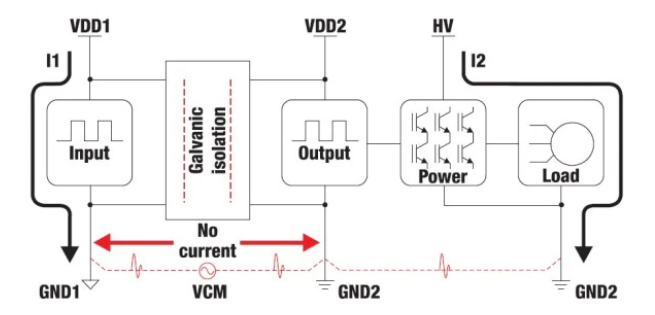
Effective isolation occurs when the ground (GND1) is separated from another ground (GND2), effectively isolating the current (I1) from the current (I2) as there is no common ground connection between them. This isolation is crucial for various applications, including preventing common ground currents and enabling signal communication without direct conduction.
Moreover, as GND2 can be set at a different floating potential relative to GND1, current isolation can be used for voltage level shifting. This feature is especially useful in high-voltage systems where bidirectional signal information needs to pass through the isolation barrier.
Many analog and digital circuits have specific bias voltage requirements, and when both digital signals and power must pass through an isolation barrier, current isolation becomes critical. For example, in the same system, an isolated high-resolution analog-to-digital converter may require a 3.3V power supply, while an isolated gate driver may need 15V and -5V. This requires not only the transmission of signals but also the passage of power across the isolation barrier to ensure that each part of the circuit operates at the desired voltage and current levels while maintaining electrical isolation.
Constructing a reliable isolation barrier in electrical systems involves various considerations, including isolation ratings, creepage distance, and clearance distance, CMTI, and electromagnetic interference (EMI). Functional isolation ensures the proper operation of the system without the risk of electric shock, typically achieved through appropriate PCB conductor spacing. Basic isolation provides safety protection that matches the highest system voltages, while reinforced isolation is the highest commercial rating for high-voltage systems, conforming to strict standards such as IEC 60747-17 and IEC 60747-5. Certified isolators for enhanced isolation in high-voltage systems require compliance with globally recognized safety standards.
Creepage and clearance distance, which refer to the shortest path that conductive leads take through the isolation barrier, are critical parameters. Packaging techniques and reinforced isolation work together to achieve greater distances. CMTI measures the ability of an isolator to handle high-speed transients, which is crucial in the presence of wide-bandgap semiconductors with high transient voltages. The CMTI rating for high-performance isolators typically exceeds 100 V/ns.
Balancing isolation at the IC and system levels involves considerations of package size, integration, thermal management, compliance with certified standards, and minimizing EMI while maintaining efficiency. Choosing isolation components designed to meet these requirements at the IC level helps achieve seamless enhanced compliance at the system level.
In the modern high-voltage systems arena, seeking isolation is a paramount concern. Enter the unsung heroes behind the scenes, tasked with blocking direct current and unwanted alternating current while facilitating the secure transmission of power, analog signals, and high-speed digital data. Three core semiconductor technologies have revolutionized isolation solutions:
Optocouplers: Imagine a dance of light and dielectric magic. The operation of optocouplers is simple yet clever: light emitted from an LED source is transmitted to a phototransistor separated by a dielectric insulating material. However, these materials have their limitations, requiring substantial physical separation to achieve higher levels of isolation. While TI does not provide optical isolation products, it offers Opto-Isolators using SiO2 isolation technology as a compelling alternative. Optocouplers may be the fastest known carriers of electromagnetic energy through photon transmission, but their data rate limit is in the range of a few megabits per second. Additionally, because current transfer varies with time, they consume more power.
Capacitive Isolation Technology: Capacitive isolators have ushered in a new era of isolation by promoting the transmission of AC signals across dielectric barriers, effectively blocking DC signals. Unlike optocouplers, capacitive isolators offer low propagation delay and data rates exceeding 150 Mbps while consuming less bias current. TI's capacitive isolators use SiO2 dielectric, boasting exceptional dielectric strength and stability. They support impressive working and surge voltage capabilities, making them ideal for low-voltage analog and digital signals.
Magnetic Coupling: Magnetic isolation with integrated planar transformers shines when high-frequency DC/DC power conversion enters the picture. It can transfer a substantial amount of power without the need for secondary-side bias power in most applications. Moreover, magnetic isolation can transmit high-frequency signals, and the same transformer windings can handle both power and data transmission.
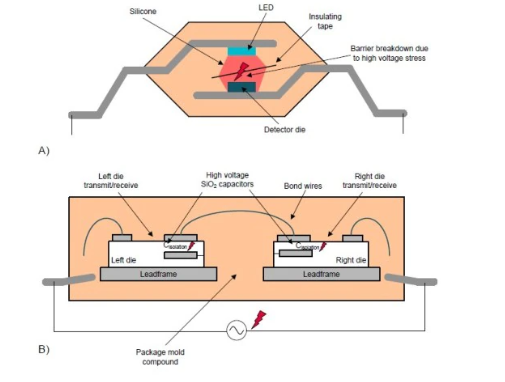
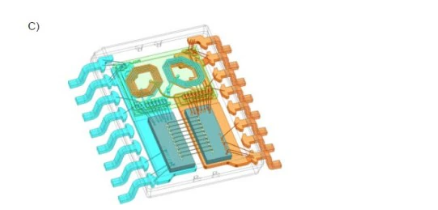
TI employs a proprietary multichip module approach to provide high-performance transformers with either ferrite or air-core. These transformers use shielding techniques to reduce EMI and ensure better radiated EMI performance.
Reliability is of paramount importance for high-voltage isolation components like Opto-Isolators, especially in harsh environmental conditions. TI employs a rigorous certification process involving third-party agencies to test and certify its parts. They conduct tests such as time-related dielectric breakdown to measure device lifetimes, ensuring a certification of at least 30 years, with the potential to exceed 40 years due to silicon's characteristics.
Mohammed stated, "High-voltage testing is performed at levels exceeding specifications, and product qualification includes various stress tests such as temperature, humidity, and vibration." "TI provides qualification and certification results on our website, ensuring transparency."
In terms of cost, TI is committed to making electronic products affordable through semiconductor technology. The company invests in research and development, process, packaging, and material development to reduce manufacturing costs. It also expands the production capacity of 300mm semiconductors, which, in the long run, will help lower costs and promote the adoption of high-voltage isolation components.
TI is committed to advancing signal isolation and high-voltage technology, holding certifications for automotive applications such as AEC-Q100. It prioritizes addressing the challenges of isolating high-voltage components in electric vehicles, emphasizing protection against rapid voltage fluctuations, surge voltage tolerance, and immunity to switch noise.
Furthermore, TI's solutions effectively mitigate EMI and electromagnetic compatibility (EMC) issues, including ground loop concerns. In the electric vehicle charging sector, the company maintains the integrity of insulating materials in connectors while providing robust communication and reliability during frequent connect-disconnect cycles.
As electric vehicles continue to evolve, the automotive industry is adopting higher battery pack voltages, reaching up to 800 volts and beyond. This voltage increase brings many advantages, including reduced vehicle weight, increased torque, improved efficiency, and faster charging capabilities. To ensure the safety and performance of electric vehicles at these high voltage levels, isolation semiconductors and signal chain ICs play a crucial role in enabling low-voltage electronics to operate alongside high-voltage battery systems with current isolation. Key electric vehicle subsystems, such as the battery management system and traction inverter, rely on this technology to maintain safety standards while enhancing electric vehicle performance.
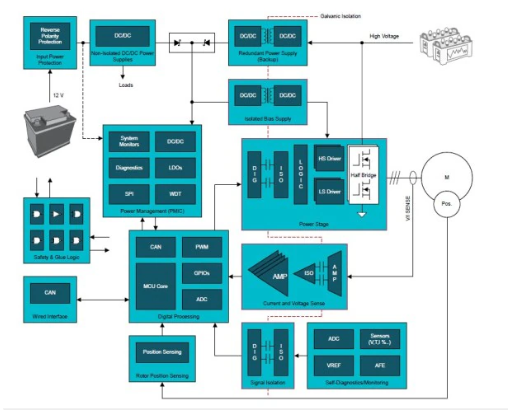
TI extends its expertise to a wide range of energy infrastructure projects, offering a range of products to meet various standards and requirements, from solar inverters to grid communications. Its commitment to network security and interoperability ensures that signals interfacing with the grid remain isolated, maintaining secure and uninterrupted communication.
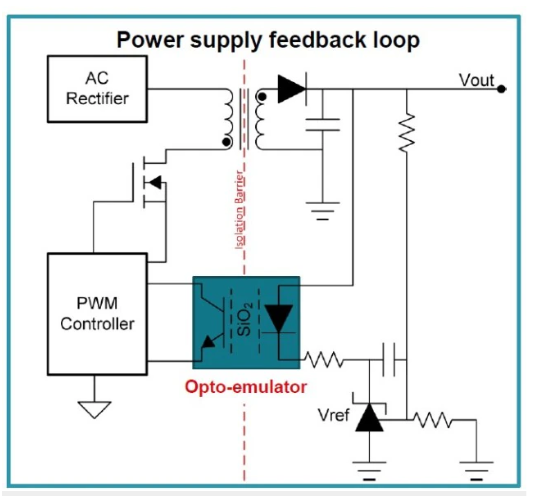
With TI's ongoing innovation, it not only introduces new Opto-Isolators and expands its isolation device portfolio, but also invests in proprietary technologies such as SiO2-based isolation to enhance product lifespan and performance, ultimately providing reliable solutions for the ever-evolving high-voltage technology and signal isolation needs.
In the field of programmable logic controllers (PLCs) and motor drives, ensuring effective isolation between different components and circuits is critical for safety, performance, and compliance with standards such as IEC 61800-5-1. Here are some key takeaways:
Isolation of Ground Loop Disconnection: In industrial environments where field-side voltages are typically 24V, PLCs often handle data from sensors or transmitters. In these low-voltage applications, basic isolation is typically sufficient to break the ground loop.
Isolation Voltage Requirements: For most low-voltage PLC applications, working voltages in the range of 100 Vrms to 500 Vrms and isolation voltages of 2.5 kVrms are typically adequate. These voltages ensure separation between circuits and components, reducing the risk of electrical interference.
Creepage and Clearance Distance: In applications with limited space, it's best to use components with smaller creepage and clearance distances. This minimizes the risk of arcing or breakdown in confined spaces.
Motor Drive Isolation: Motor drives typically include isolation barriers between power and control circuits.
This isolation is achieved using isolated semiconductor components.
Isolated Gate Drivers: Isolated gate drivers play a crucial role in isolating microcontrollers (MCUs) that generate pulse-width modulation control signals from high-power electrical components. This isolation protects MCUs from the impact of high-power electrical components.
Noise Interference and Safety: Electrical isolation in motor drive applications must minimize noise interference between power and control circuits to ensure reliable operation and safety for operators.
IEC 61800-5-1 Compliance: Modern motor drive systems need to comply with safety standards such as IEC 61800-5-1. Complying with these standards is crucial to ensuring the safe and reliable operation of industrial machinery.
TI states that this new experience improves signal integrity and significantly increases power efficiency by up to 80% compared to traditional optocouplers with these advanced devices. These Opto-Isolators, named ISOM8710 and ISOM8711, are designed to match the footprint of existing optocouplers.
They use five-pin and four-pin SOIC packages with dimensions of approximately 4.5 to 5 mm in width and 3.5 to 3.8 mm in height, occupying an area of about 17.5 square millimeters. Additionally, efforts are underway to introduce more compact and smaller packages in the future. For example, the ISO 6510 is a dual-channel isolator that can be used in a small DMS package measuring 3x2mm², making it the smallest package in TI's isolation device portfolio. The company is committed to meeting customer demands for compact solutions while ensuring the necessary isolation requirements for high voltage.
Overall, Texas Instruments' introduction of the ISOM8710 and ISOM8711 Opto-Isolators represents a significant advancement in signal isolation technology, offering improved performance, wide operating temperature ranges, and compatibility with existing optocouplers. These devices are designed to enhance signal integrity, reduce power consumption, and extend the lifespan of high-voltage industrial and automotive applications. With their proprietary SiO2-based isolation technology, TI aims to address long-term challenges associated with aging effects common in optocouplers, offering a more reliable and efficient choice for high-voltage signal isolation in high-pressure systems.
If you have any further questions or need additional information, Feel free to contact us any time. If you have any needs for products, please contact our sales staff for inquiry. https://www.censtry.com/inquiry.html